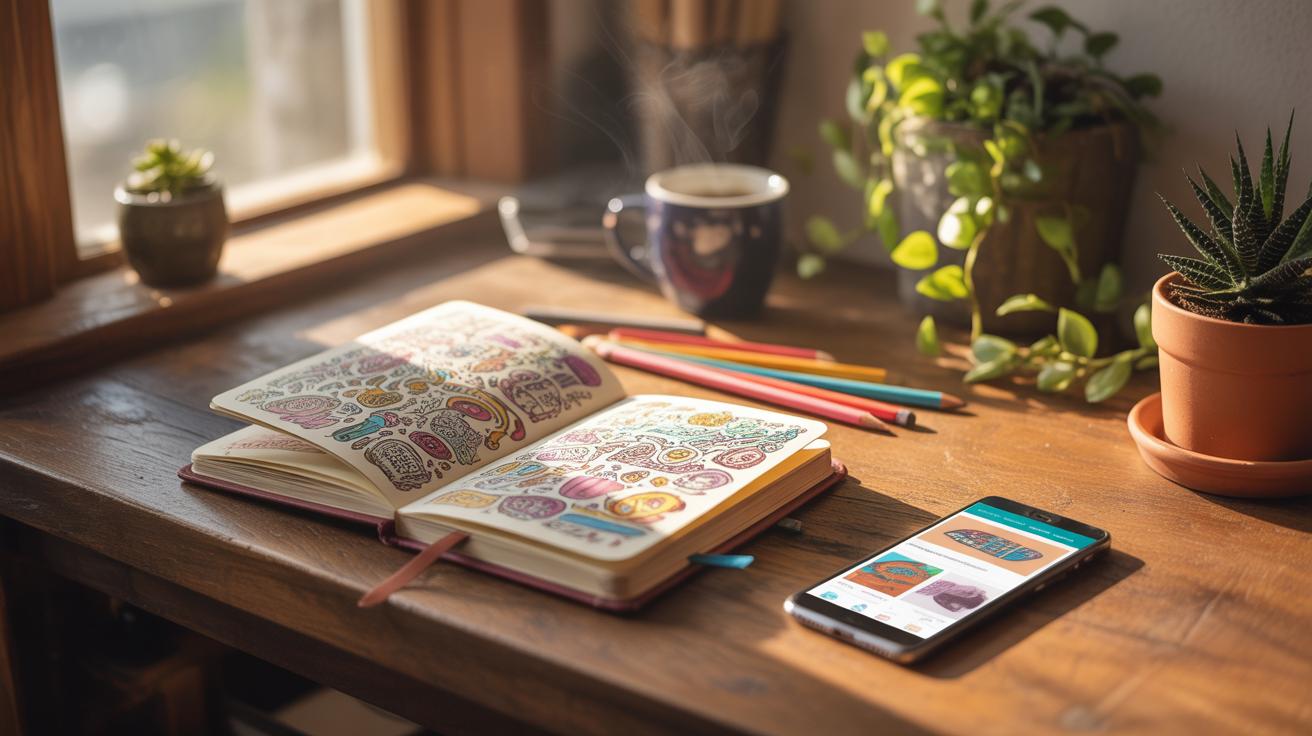
Creative Things to Write in Diary for Your Daily Life
Introduction
Writing in a diary can be more than just a record of your day. It is a chance to explore your thoughts, feelings, and experiences creatively. ‘Creative Things to Write in Diary for Your Daily Life’ offers new ways to enjoy diary writing and make it more meaningful.
This article will guide you through imaginative ideas and simple tips to enrich your diary entries. You will learn how to transform your daily routine writings into something exciting and reflective. Discover how to make your diary a source of inspiration and personal growth.
Express Your Emotions
Writing in your diary can be a powerful way to sort through feelings that often feel tangled or unclear. When you take the time to write about your emotions—whether it’s frustration from a small argument or quiet joy from a simple moment—it helps you see those feelings more clearly. Sometimes, just naming what you’re feeling lets the intensity soften a bit.
Understanding emotions this way matters because it gives you space to grow. When you recognize patterns in how you react or which emotions keep showing up, you start learning about yourself in ways that don’t happen through thinking alone. It’s like having a conversation with yourself where you ask, “What really is going on here?” and the diary nudges you toward answers.
Why Show Your Feelings
Not everyone feels comfortable admitting what’s going on inside. But writing those feelings down can bring relief, even if only small. When you write about sadness, anger, or confusion—it’s not just about letting off steam. It’s about acknowledging your experience, which can make you feel less isolated or overwhelmed.
Sometimes, the act of seeing your thoughts on paper changes how you view them. You might find yourself understanding why something bothered you more than you thought, or why a happy moment felt so significant. This process helps you connect with yourself in a way that’s, well, honest, not just surface-level.
Ways to Describe Emotions
Writing about feelings doesn’t have to be only straightforward descriptions. You can use colors to represent moods—maybe blue for calm or red for anger. Symbols work too, like drawing a storm cloud or a small flower beside a journal entry to hint at what you felt.
If you enjoy storytelling, you could invent a short story or scene that captures the emotion. Imagine a character facing the same feeling you had and explore their reaction instead of writing plainly about yourself. This distance might help you express things you’d hesitate to say outright.
Other times, a single word or a brief sentence captures your feeling better than an extended explanation. The goal isn’t to be perfect; it’s to find a way to get what you’re feeling out. Have you tried assigning a color or creating a symbol to describe how your day felt? It might change how you understand your emotions next time you write.
Record Daily Highlights
Not every moment you live through needs to go into your diary. Picking what to write might feel overwhelming—there’s so much that happens, right? Yet, choosing the events that stick with you or carry some meaning can turn your diary into a treasure of memories and insights. Think about what made you pause during the day: a short conversation that shifted your mood, a small success, or even a mistake that taught you something unexpected.
When deciding what to jot down, ask yourself questions like: Which moments surprised me? Which ones made me see something differently? Or maybe, what did I struggle with today? These questions help narrow down what really counts.
To keep your writing lively, try mixing styles. Write a brief dialogue that captures an exchange you had, sketch a quick doodle of something unusual you noticed, or list out your day’s three favorite things. These small changes break monotony and make your diary a bit more fun—not just another routine task.
Sometimes, scribbling the highlights feels easier when you don’t have to stick to full sentences. Jotting down a funny quote your friend said or drawing a tiny scene can bring your memories alive. It’s not about perfect writing—it’s about catching those moments that might otherwise slip away.
Set Personal Goals
Writing down your goals in a diary can shift how you approach each day. When you put your thoughts on paper, your intentions become clearer. It’s like creating a personal roadmap for what you want to achieve, and somehow, it makes you more likely to follow through. Maybe it’s because the act of writing forces you to slow down and focus on what matters right now.
Start small. That’s key. Instead of overwhelming yourself with big ambitions, jot down goals that feel manageable. For example, rather than “get fit,” try “walk 10 minutes after lunch.” These small steps add up. They create a sense of accomplishment that encourages you to keep going—even on days when motivation feels thin.
Tracking your progress is where the diary really shines. Write about what worked and what didn’t. Did you meet your goal today? If yes, celebrate it briefly—maybe just a line of praise or a smiley. If not, note what got in the way. Over time, you’ll start seeing patterns. Your diary becomes a tool not just to plan but to learn and adjust. This ongoing record can reveal surprising insights about how you move toward your dreams—or stall.
Create Gratitude Lists
Writing a daily list of things you’re grateful for can shift your focus away from stress or negativity. It nudges you to notice the small, often overlooked parts of your day that bring comfort or joy. Over time, this simple habit can brighten your mood and make you more aware of what’s actually going well, even on rough days.
Why Gratitude Helps
Feeling thankful triggers emotional responses linked to happiness and calm. When you focus on gratitude, your brain releases chemicals like dopamine and serotonin, which can improve your mood. At the same time, it lowers the cortisol levels that come with stress. It’s a bit like retraining your mind to see beyond problems, though sometimes this can feel forced or tricky. The genuine moments of gratitude, even small ones, seem to stick more than the generic or expected ones.
Making a List
Try these steps to create your own gratitude list:
- Start by recalling three specific things from your day. Details matter—“the coffee I had this morning” feels more real than “coffee.”
- Write them down in your diary without judging or overthinking them. If you struggle, consider people, moments, or even challenges that taught you something.
- Don’t worry about the order or the importance. Every note counts, whether it’s big or small.
- Read the list aloud or silently to yourself. Notice if it changes how you feel.
- Keep it short. Even a few lines can influence your outlook for hours.
Over time, you might spot patterns in what makes you feel grateful. This process isn’t about forcing positivity but about opening a window to what’s already there, waiting for you to see it.
Use Prompts to Inspire
Sometimes, staring at a blank page feels like an impossible task. That’s where prompts come in handy. They give you a little nudge, a starting point to unlock thoughts that might be just beneath the surface. Prompts can turn your diary from a chore into a small, daily adventure.
There are plenty of prompt types to pick from, depending on your mood or what you want to explore:
- Questions about dreams—what did you just dream? Does it feel meaningful or bizarre?
- Memories—what’s a moment from your past that still sticks with you? Why does it linger?
- Daily experiences—what made you smile, or frustrated you, today? What small detail caught your eye?
- Feelings—how do you feel right now, and what might be behind those emotions?
- Hypotheticals—what would you do if you had an extra hour today, or a million dollars?
Pick a prompt that sparks at least a small interest or curiosity. Then, just start writing—don’t worry about perfect answers. You can dig into a memory, question your feelings, or even write a list of associated thoughts. Be open to where your mind leads you. Maybe one prompt starts as a simple answer but grows into something more personal or surprising as you continue.
For instance, I once used a prompt about “a moment you wish you could relive” and ended up remembering an entire afternoon with an old friend, complete with forgotten details that brought a smile. Prompts can help move past dry spells—and even reveal things about yourself you didn’t expect to find.
Draw and Doodle
Adding drawings or doodles to your diary entries can make your writing feel more alive. Sometimes words just don’t capture what you really want to say. When you draw, you tap into a different part of your brain. It can reveal emotions or thoughts that you might not even understand fully yet. I remember one day when I was too tired to write, so I just sketched a simple sun and some clouds—giving me a clearer sense of my mood than any sentence could.
You don’t have to be good at drawing. Simple shapes and quick doodles work perfectly. Even a few lines or a squiggle can add something unique to your page. It’s not about art skills but about self-expression. Try little faces, plants, or abstract patterns.
Mixing your words with images creates a richer experience, both while you’re writing and when you look back later. It breaks up the text and gives you a visual memory paired with your thoughts. Your diary becomes more than text; it feels like a small, personal scrapbook. What kind of things would you doodle today?
Write About Dreams
Dreams often feel like fragments drifting just out of reach, yet they hold parts of your mind you rarely see when awake. Writing them down in your diary can open unexpected doors to understanding your deeper thoughts and emotions. Sometimes, a dream might reflect worries you didn’t realize you had or hint at hopes you’ve pushed aside. Other times, they seem like random nonsense—but even that randomness can be telling.
Remembering Dreams
If you want to capture your dreams, try to keep your diary or a notepad close to your bed. The moments right after waking are the most crucial for memory. Even if all you recall is a single image or feeling, jot it down immediately. Don’t worry about making sense or having a full story. Just capturing that vague sense can be surprisingly helpful later, especially as you start connecting patterns. Something I found useful is lying still for a moment and trying to replay the dream in your mind before writing anything. It’s tricky—you might forget bits quickly—but it often helps pull more details to the surface.
Dream Meanings
Interpreting dreams is far from exact, and that’s part of the richness. Instead of searching for fixed meanings, consider what the images or emotions might represent to you personally. Ask yourself questions like:
- What was the main feeling in the dream—fear, joy, confusion?
- Are there people or places that feel familiar or strange?
- Does this remind you of something happening in your real life?
Sometimes a dream uses symbols that only make sense to you. For example, a locked door could mean feeling stuck, or it might just be about a place you visited recently and nothing more. Let your diary become a space to explore those meanings without pressure. You might be surprised how writing about dreams gradually deepens your understanding of yourself, even if the meaning isn’t clear right away.
Ask Yourself Questions
One way to add depth to your diary writing is by asking yourself questions. It’s not always easy to do, but posing simple, thoughtful questions helps you uncover what’s really going on inside your mind. Instead of just writing about events, try to explore your feelings and motivations through inquiry.
Try these questions, for example:
- What made me happy today?
- What did I find challenging, and why?
- Was there a moment I felt misunderstood?
- What am I avoiding thinking about?
- How did I react differently than usual?
Answer these questions honestly, even if the answers feel uncomfortable or unclear. Your diary is a private space where truth helps more than pretending everything is fine. When you really try to pinpoint your feelings or motives, you often discover patterns or insights you wouldn’t notice otherwise.
Sometimes, a question might bring up more questions—or no clear answer at all. That’s okay. The process is valuable. It encourages you to slow down and listen to your thoughts rather than just summarize your day. Over time, these honest reflections make your diary entries feel more meaningful and genuine. Give it a try—you might surprise yourself with what you uncover.
Plan Your Future
Your diary can be more than a record of what happened today—it can become a place to imagine what might happen tomorrow, next year, or even a decade from now. Try using it to write down your hopes and plans for the future, without worrying too much about whether they seem realistic right now. Sometimes, just putting a dream on paper makes it feel more real and gives you a clearer idea of what you want, even if you’re a bit unsure about the details.
Dream Big
When you write about your future, don’t hold back. Think about what you’d want if there were no limits—no money worries, no time constraints, no doubts. Maybe you want to live in another country, start a business, learn something new, or make a big lifestyle change. Write it all down, even the ideas that seem far-fetched or silly.
You might notice that as you dream freely, new possibilities pop up—things you hadn’t considered but which excite you for reasons you don’t quite understand. At first, these dreams may seem scattered or unrealistic, but that’s okay. Dreams often grow clearer over time, especially when you revisit them regularly.
Make Steps
Big plans can feel overwhelming. Breaking them into smaller, manageable steps helps you move forward without getting stuck. In your diary, try outlining what you need to do first, second, and so on. For example, if your dream is to write a book, your steps might be:
- Research your topic or genre
- Outline the chapters
- Write a page a day
- Ask for feedback from a friend
- Revise and edit
Track your progress regularly. When you check off even a small step, it can boost your motivation and help prevent procrastination. You don’t need to have every detail figured out. Sometimes, just deciding on the next tiny action is enough to keep you moving.
What’s the one small thing you could do tomorrow toward a future you want? Writing it down is the first step. And yes, it’s perfectly fine if plans change as you go along—it’s part of the process.
Conclusions
Keeping a diary with creative ideas can turn an ordinary habit into a rewarding journey. You are encouraged to express yourself fully and invent new styles of writing that reflect your unique life. This practice helps you stay connected with your feelings and track your personal progress.
Your diary can become a trusted companion that supports mental clarity and encourages self-discovery. By applying these creative approaches, diary writing will stay fresh, enjoyable, and valuable for years to come. Start today and see how your diary evolves into a personal treasure.






















